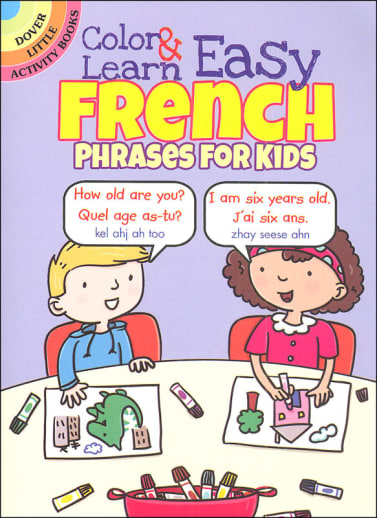Kids can color along as they master practical words and phrases in French. More than 60 pages of fun, kid-friendly illustrations accompany English translations of French words and pronunciations for such basics as numbers, colors, and the days of the week. Also, helpful conversational phrases include "What's your name?" "Where's the bathroom?" and many other expressions.
Color & Learn Easy French Phrases for Kids
SKU
064089
ISBN
9780486803616
Grade K-3
Neutral
Consumable
These icons are designed to help you quickly understand and learn important information about our products.
Teaching Method
Traditional
Teacher-centered curriculum commonly used in classrooms that may include a text, teacher manual, tests, etc.
Charlotte Mason
A methodology based on the work of a 19th century educator who maintained that children learn best from literature (Living Books), not textbooks.
Classical
A methodology based on the Latin Trivium (three stages of learning), including the grammar stage (memorization and facts), logic stage (critical thinking), and rhetoric stage (developing/defending ideas).
Unit Study
A thematic or topical approach centered around one topic that integrates multiple subject areas.
Montessori (Discovery)
A methodology based on the work of a 20th century educator that emphasizes student and sensory-driven discovery learning and real-life applications.
Other
Other methodologies
Religious Content
Secular
Contains content contrary to common Christian beliefs (i.e. evolution).
Neutral
Avoids religious or theoretical topics or presents multiple viewpoints without preference.
Christian/Religious
Faith-based or including instructional religious content.
Learning Modality
Auditory
Learns through listening, talking out loud or reading out loud.
Visual
Learns through seeing, prefers written instructions and visual materials.
Kinesthetic/Tactile (Hands-On)
Learns through moving, doing and touching.
Multi-Sensory
Curriculum that employ a variety of activities/components.
Presentation
Sequential
Curriculum progresses through well-defined learning objectives. Emphasizes mastery before moving to the next topic.
Spiral
Topics and concepts are repeated from level to level, adding more depth at each pass and connecting with review.
Conceptual/Topical
Focus is on the “why,” often with a unifying concept as well as specific skills; coverage may be broader.
Teacher Involvement
Low Teacher Involvement
Student-led materials; parent acts as a facilitator.
Medium Teacher Involvement
A mix of teacher-led time and independent student work.
High Teacher Involvement
Teacher-led lessons; may utilize discussions, hands-on activities and working together.
Additional Materials Required
No other materials needed
Everything you need is included.
Other Materials Required
There are additional required resources that are a separate purchase.
Other Materials Optional
There are additional resources mentioned or recommended but are not absolutely necessary.
Consumable
Consumable
Designed to be written in; not reusable.
Non-Consumable
Not designed to be written in; reusable.
Our Price
$2.99 $2.99 $2.45
Rainbow Savings: $0.54
Description
Publisher's Description of Color & Learn Easy French Phrases for Kids
Category Description for Color and Learn Easy Phrases for Kids
Tiny books from Dover have a lot to offer in a small package! Each book shows children in situations having a conversation. You see the speech bubbles in the foreign language with a phonetic English pronunciation below. At the bottom of each page is the English translation. The phrases center around things in a child's world: food, family, playing outside, pets, friends, clothing, days of the week, etc. I really like that they are not just static images with a vocabulary word, but rather showing the words in use. Keep one in a purse or bag for when you need a meaningful, quiet activity! About 4x6", 62pp ~Sara
Details
| Product Format: | Paperback |
|---|---|
| Grades: | K-3 |
| Brand: | Dover Publications |
| ISBN: | 9780486803616 |
| EAN/UPC: | 800759803613 |
| Length in Inches: | 5.75 |
| Width in Inches: | 4.0625 |
| Height in Inches: | 0.1875 |
| Weight in Pounds: | 0.1 |
Videos
Reviews

